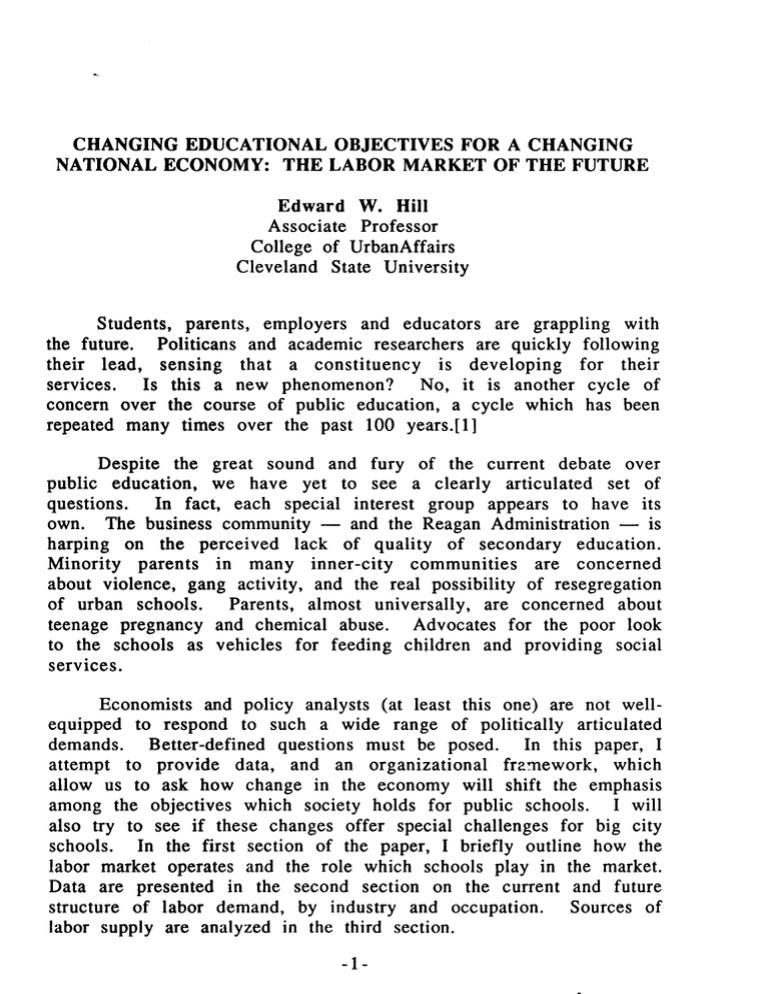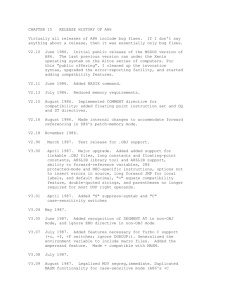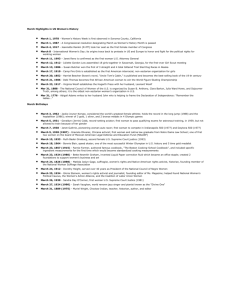CHANGING EDUCATIONAL OBJECTIVES FOR A CHANGING
advertisement

CHANGING EDUCATIONAL
OBJECTIVES FOR A CHANGING
NATIONAL ECONOMY:
THE LABOR MARKET OF THE FUTURE
Edward W. Hill
Associate Professor
College of UrbanAffairs
Cleveland State University
Students, parents, employers and educators are grappling with
the future.
Politicans and academic researchers are quickly following
their lead, sensing that a constituency
is developing
for their
services.
Is this a new phenomenon?
No, it is another cycle of
concern over the course of public education, a cycle which has been
repeated many times over the past 100 years.[l]
Despite the great sound and fury of the current debate over
public education, we have yet to see a clearly articulated set of
questions.
In fact, each special interest group appears to have its
own. The business community -and
the Reagan Administration -is
harping on the perceived lack of quality of secondary education.
Minority
parents in many inner-city
communities
are concerned
about violence, gang activity, and the real possibility of resegregation
of urban schools.
Parents, almost universally,
are concerned about
teenage pregnancy and chemical abuse. Advocates for the poor look
to the schools as vehicles for feeding children and providing social
services.
Economists and policy analysts (at least this one) are not wellequipped to respond to such a wide range of politically
articulated
demands.
Better-defined questions must be posed.
In this paper, I
attempt to provide data, and an organizational
fr~~ework,
which
allow us to ask how change in the economy will shift the emphasis
among the objectives which society holds for public schools.
I will
also try to see if these changes offer special challenges for big city
schools.
In the first section of the paper, I briefly outline how the
labor market operates and the role which schools play in the market.
Data are presented in the second section on the current and future
structure of labor demand, by industry and occupation.
Sources of
labor supply are analyzed in the third section.
-1-
performance
of manufacturing
influences
total employment.
Not
only is it a dominant employer in its own right, but it has large
multiplier
effects.
The degree to which states in the East North Central region
remain dependent on manufacturing
is clearly demonstrated in the
lower half of Table 1. All of these states, again with the exception of
Illinois,
have a much larger
share of their
employment
in
manufacturing
than the nation as a whole.
Continued reliance on
manufacturing leads to the expectation of further employment losses,
as manufacturing
becomes less labor intensive nationally.
However,
we can also expect that manufacturing
will remain an important
component of the economic fate of the Midwest. In fact, whether the
United States remains a manufacturing
power depends in no small
part on the performance of factories in the East North Central United
States.
Expected
Employment
Patterns
by Industry
Employment will grow at vastly different rates for the various
industries in the nation.
Table 2 provides detailed information
on
annual average rates of change in employment by industry, for the
nation, from 1959 to 1986; it also contains the Bureau of Labor
Statistics {BLS) moderate projection
of employment
for the year
2000.[5]
The employment
structure
which
emerged from the
recession of 1979 should continue for the rest of the century.
The
overall rate of employment growth is expected to be lower than at
any other non-recessionary time period in the post-war era.
Construction is predicted to experience employment gains, but
these gains will be offset by losses in the other sectors of the goods
producing economy: manufacturing and mining.
The good news from
the manufacturing sector is that while employment will be declining,
output is expected to increase at 2.3 percent per year. Productivity
should increase at a faster rate.
This means that value added will
increase, implying
that it is possible for manufacturing
workers to
earn increases in real income.
Employment
will
continue to be gen~rated by the service
producing sector of the economy.
The rate of growth will be less
than it has been in the recent past. Most of the growth will come
from wholesale and retail trade and the service industry.
{Service
industries are a component of the service-producing
sector of the
-5.
~
But
blue
they
collar
project
an
increase
of
nearly
8
percent
in
the
number
of
supervisors.
The projections
also reflect
a shift from employment
in
manufacturing
to an increase in upstream employment,
distribution
and sales.
(This probably
reflects
the internationalization
of
manufacturing.)
There will be an increase among those occupations
which
handle,
store, and sell goods.
These occupations
are
transportation and material moving, marketing and sales and helpers
and laborers.
The projections also reflect an increase in the number of skilled
crafts workers in the economy. (Most are in the construction trades.)
There is also an increase in the number, but not the share, of
mechanics and precision production and plant systems workers.
In
sum, blue collar America's share of employment will continue to
decline.
Today 27 percent of all jobs can be considered to be bluecollar jobs; at the turn of the next century this will be reduced to 24
percent.
The economy will shed less skilled blue-collar occupations
and retain
those which
require
more judgment,
expertise
and
learning. The decline will be much more dramatic if demand for
workers by the construction industry does not keep pace with the
moderate projections of the BLS.
White collar occupations will continue to generate the most
new jobs.
Nearly a quarter of all workers will be classified as
executives, managers, or professional
workers by the end of the
century.
The current rate of growth in these occupations will be
maintained.
Natural scientists and computer specialists and workers
in the health professions face the best employment prospects.
Educational
Attainment
Employment projections are nice abstractions, especially when
considering
an end point which is 15 years in the future.
The
economy
is dynamic
and projections
are based on a raft of
assumptions and constructed
with a set of elegant straight line
techniques.
It is highly likely that actual levels of employment in
2000 will not exactly match those generated by the BLS's analysts
and computers.
But they serve a purpose.
They help us understand
the rough competitive position of the economy and alert us as to
what the demand side of the labor market (employers)
will be
looking for from the supply side (people and schools).
The labor
-7.
Two limitations to this analysis are presented at the outset.
I
do not address matters of teaching modality. [2]
And I do not
examine the internal organization of schools.
These subjects are not
policy issues.
They are questions about appropriate
educational
technology -better
left to my colleagues in schools of education.
I
examine demands which will be placed upon schools by the economy.
A TOUROFTHELABOR MARKET
Consumers do not purchase labor directly.
They buy products,
goods and services.
Products contain varying amounts of labor
content and demand for labor is derived from, or created by, product
demand.[3]
Before the demand for labor can be forecast, product
demand by consumers, businesses and government must be known.
The labor market is one of the most important markets in the
economy because it is the dominant source of income and it is a
critical link in macroeconomic policy.
Yet, policy-makers
are not
concerned about the market for a particular product by and of itself;
they are concerned about workers in particular industries.
When I
teach about the workings
of the labor market and digress into
discussions about products my students become confused and I begin
to feel like Copernicus.
My students feel that the labor market is the
center of the universe.
Yet, I insist that they think about products.
Which is the true center of the universe? It is the product market.
Employers combine labor and capital in a production process.
The amount of each factor used depends on technical requirements
and the relative cost and productivity of each factor used. However ,
producing
the good, supplying
it to consumers on the product
market, is not enough.
Demand and supply must interact.
The
amount sold depends on the producers' price and consumers' level of
demand at that price.
If the pattern of demand shifts over time,
with products
entering
and leaving
the marketplace,
consumers'
willingness to buy at a given price will change. All of these forces
directly influence the amount and type of labor which is demanded
by employers.
In the smooth and orderly world of theoretical
economics,
employers line up potential workers in a queue, ranking them by
their
potential
productivity.
Employers
calculate
how much
additional output each worker will contribute and the value of that
output on the product market.
Employers will negotiate a wage offer
-2-
labor.
There will be substantial, but declining demand for workers
with limited skills and educational backgrounds.
The labor prospects
for dropouts, illiterates
and those incapable of learning throughout
-their work-lives
will continue to crumble.
There will be increased
demand for workers who can think and learn abstract concepts.
What is not known is the degree to which the labor market will
monetarily reward those capable of the latter type of learning.
This
depends on the supply of such labor and the reservation wages of
our more learned workers.
In sum, it m.eans that schools will
become more important economic development resources.
CURRENT AND FUTURE DEMAND FOR LABOR
Recent History
A great deal has been written in the popular press and by
academicians about changes in employment in the United States and
in the nation's historical manufacturing belt since 1979.[4]
A longterm trend
away from
manufacturing
toward
service
industry
employment was accelerated by two recessions, in 1979 and 1982.
In the Midwest
the recovery
between these recessions
never
materialized.
The Midwest lagged, in large part, because higher
paying service employment, which buoyed the recovery, was located
outside of the region.
The secular shift in product demand, combined
with
the recessions
and slow recovery,
makes it difficult
to
understand what happened to this regional economy. We are only
beginning to disentangle the events using recently released statistics.
Data presented in Table 1 measure changes in employment for
the nation and various regions from the 1978 business cycle peak to
year-end 1986.
All data are annual averages. They clearly indicate
that the regions which
were most dependent on manufacturing
employment have lagged in the recovery, the only exception being
New England.
The difference lies in the fact that New England's
manufacturers
specialized
in electrical
equipment,
computing
products and defense industries.
The largest loss in manufacturing employment was during the
first recession, 1978-1982.
These losses were concentrated in the
East North
Central
Census region.
Manufacturing
employment
recovered to a limited extent from 1982 to 1986 in all of the East
North Central states, with the exception of Illinois.
What is most
striking about the employment figures ~s the extent to which the
-4.
~
economy .)
The BLS expects that almost
80 percent
of all
employment will be in the service producing sector of the economy.
(See Table 3) Employment in manufacturing will drop to 15 percent
of non-farm wage and salary employment, from 26 percent in 1972
and 19 percent today.
This is a loss of an additional
830,000
manufacturing
jobs. But manufacturing
will remain a significant
employer.
Jobs in manufacturing will be generated by turn-over, not
by growth, due to the high average age of manufacturing workers.
It is easier to understand the future structure of employment
by examining the net number of jobs which will be created in each
industry over the next 15 years.
Some industries are expected to
expand, others contract.
The net numbers of jobs created, by
industry, are displayed in Table 4. The last column shows the percent
distribution
of new openings.
Nearly 87 percent of new openings will be in service-producing
sector; 43.17 percent in the service industries.
The three industries
which will
generate the largest employment
increases are Retail
Trade, Business Services, and Health Care Services.
The next largest
source of employment growth will be among the self-employed; they
will count for 9 percent of all new jobs. Finance, Insurance and Real
Estate and Wholesale Trade will both grow slowly.
The
continued
shift
in
employment
demand
from
manufacturing
to services has three important
implications
for
society:
the pattern of occupations will change; the distribution
of
earnings available
in the economy will
shift; changes in labor
demand by industry and occupation wiR influence the educational
requirements which must be met by American workers.
Each will be
addressed in the remainder of thispaper.
The Occupational
Picture
Table 5 presents information
on the occupational distribution
of employment
in the nation in 1986 and the ~LS's projected
distribution,
under the moderate scenario, for 2000.
Growth rates
from 1972 to 1979 and from 1979 to 1986 for major occupational
groupings are also displayed.
Employment in manufacturing is expected to decline by about
4 percent from 1986 to 2000.
Yet the change in all traditional
manufacturing occupations does not decline by an equal percentage.
The BLS projects that there will be declines of about 4 percent for
machine setters and operators, assemblers and other hand -workers.
-6-
up to the value of the worker's marginal product.
If the potential
employee is willing to work for that wage a deal is struck and the job
is filled.
In the real world, choices are not quite as obvious.
It is
difficult
to evaluate the potential productivity
of workers without
having them actually demonstrate their ability on the job.
In many
situations
even this will
underestimate
productivity,
as workers
often become more efficient as they perform the job; this is called
learning-by-doing
or on-the-job training.
Instead, employers look at
a number of factors which serve as predictors of productivity.
In
some cases, they pay attention to references, at other times formal
credentials
such as diplomas, and in a few situations
they will
perform job-specific
testing.
Economists view schools as providing three products.
The first
is learning.
Individuals
invest in their own careers by attending
school and obtaining
human capital.
The second is vocational
training, which tends to be more job specific -it
is not valued by a
wide variety of employers.
Economists also view schooling as a
consumer good.
This is the component of learning which is not
directly valued by the labor market; it has entertainment value.
Schools, and degrees, are an essential part of the supply side of
the labor market.
Education helps transform people into valued
ingredients
for the production
process.
Wages, when based on
productivity,
are indirectly
related to the quality and quantity of
education.
It is assumed that in the short run educational credentials
are what employers
hold dear, as indicators
of the potential
productivity
of the employee.
But as employers gain experience in
evaluating
credentials,
they are discounted accordingly.
If some
schools provide credentials of inconsistent value, or are consistently
of little value, they will be ignored.
Returns to labor, and indirectly
to education, are driven by
competition in the product market.
The United States has lost its
comparative advantage in routinized manufacturing.
We have seen
our growth rate decline when compared to both the industrialized
nations and the newly industrialized countries of the Pacific rim.
Our
advantage lies in capital intensive and innovative manufacturing and
in services.
What does this imply
for
production
of goods and services
schools?
It implies
requires two different
that the
types of
.
-3-
force of the year 2000 is largely with us -the
oldest are currently
41 years of age, the youngest are 4.
The oldest part of the labor
force will be aging baby boomers, the core of the labor force will be
members of the birth dearth generation, and the entrants will be the
echo -children
of the boomers.
In sum, the performance of our
schools over the next decade will go a long way toward determining
our economic fate, the wealth of the nation.
The occupational groups listed in Table 6 are classified by the
degree of educational attainment required to qualify for the jobs of
the future.
There is a positive relationship
between the level of
educational attainment required for an occupational
group and its
growth rate.
Product demand has shifted, and will continue to shift,
towards
goods and services
which
require
people with
more
sophisticated skills as part of their production process.
The last
column of the table shows the distribution
of new jobs created, by
occupation, from 1986 to 2000, grouping them by the required level
of educational attainment.
The smallest number of oper.ings will be generated in those
occupations requiring the lowest level of education, Group III.
This
reflects absolute declines in factory and farm work. The data reveal
that those Americans with the lowest levels of education will be
assigned to driving
trucks and working
in service industries .
cleaning buildings, preparing and serving food, working as nursing
aides and other medical assistants, and performing
unsophisticated
personal services.
The highest growth rates are reserved for those occupations
requiring the greatest academic achievement.
Educational Group I
will account for nearly 38 percent of net new job openings generated
by our economy.
In fact, the number of openings for professional
workers alone will nearly match all of those available for Educational
Group III.
These projections are for the gross number of j()bs in the year
2000. They do not reflect the gross number of job openings, which is
influenced by the age distribution
and labor force participation rates
of those currently holding the positions.
For example, the growth
rate for teachers is 15.6 percent. But the median age of all teachers
in 1983 was 39 years old, compared to 33 in 1972. Only 22 percent
of all teachers are younger than 30.[6]
At least 35 percent of today's
teachers will retire before the year 2000; this is after making the
(unlikely)
assumption that there will be no turnover for reasons
-8-
precursor
for
increased
productivity
in
a technologically
advanced
society.
~
There will be wide differences
among the growth rates of
different age-sex -race cohorts in the labor force.
The group which
traditionally
has the greatest attachment to the labor force, men
from age 25 to 54, is expected to have an annual average growth rate
of 1.3 percent.
Women of the same age will have a growth rate of
2.2 percent.
Three cohorts in the labor market are expected to
decrease in size over the next fifteen years.
The labor force
participation of males of retirement age will decrease by 2.0 percent
per year and the female rate will decrease by 1.1 percent per year .
This is at a time when these cohorts will comprise an increasing
share of the population.
The youngest age group in the labor force,
those age 16 to 24, will also have a negative growth rate. The male
rate will be -0.4 percent while that of women will hover near no
growth.
The composition
of the working-age
population
will
be
different in the next century.
It will be proportionately
less white,
83.6 percent versus the current 86.1 percent. The black share of the
population will climb from 11.1 percent to 12.1 percent.
And the
fastest growing portion of the population is composed of those with
Hispanic
surnames, increasing
from 6.8 to 10.0 percent.
The
population will also be proportionately
older.
The largest gain will
be among those age 25 to 54; the largest loss will be those aged 16 to
24.
Growth rates in the size of the labor force are a product of two
factors, changes in the size of the population and in the labor force
participation rate (LFPR).
The LFPR is the portion of a cohort which
will enter the labor force.
I will examine the 16 to 24 year old
cohort of men and women to illustrate the interaction between these
two variables.
-~
The actual size of the 16 to 24 year old cohort, the raw
population, for men and women will decrease. The LFPR for young
men is currently 73.0 percent; it is expected to increase to 74.7
percent in the year 2000.
But the increase in the LFPR will not
counteract the expected 1,284,000 person decrease in the population.
This is contrasted with the expected behavior of young women.
Their LFPR should increase from 64.3 percent to 69.5 percent, nearly
offsetting the expected 1,294,000 person decrease in the size of the
-11-
~
~
cohort.
The decrease in the size of both groups is nearly equal but
their labor force growth rates will be different due to their LFPRs.
~
The largest changes in the work force will not be due to the
composition of the population but to changes in the LFPRs of the
different
cohorts.
This is a continuation
of a trend which first
appeared in the mid-1960s.
~
All male participation rates will decline, with the exception of
the 16 to 24 year old cohort.
But the decline in the LFPRs of men
will be partly offset by increases in the female LFPRs, again with the
single exception of those older than 65. The LFPR of prime age males
will decrease from 93.8 to 92.6 percent; that of prime age women
will increase from 70.8 to 80.8 percent.
The largest decrease in
LFPRs will be among older men. The rate for men age 55 to 64 will
drop from 67.3 to 63.2 percent and for men 65 years or older it will
decrease from 16.0 to 9.9 percent.
Declines in the LFPRs of young black male workers has become
a major concern. The decline is evident for 16 to 19 year old men, as
well as 20 to 24 year olds.[9]
The LFPR of black male teens in 1965
was 51.2 percent,
the 1985 rate was 44.6 percent.
(The
corresponding
white rates were 54.1 percent and 59.7 percent
respectively .)
The LFPR for black men age 20 to 24 has also
decreased dramatically.
The LFPR in 1965 was 89.8 percent, in 1985
it was 79.0 percent. ( The white rates were 85.3 percent and 86.4
percent.)
In both
cases, white
rates
have increased
and
corresponding rates for blacks have decreased.
In both cases, the
black population was also starting with a lower participation rate.[10]
All of these factors will have major impacts on the composition
of the labor force in the year 2000.
The labor force will become
slightly older, more female, and less white.
And, most importantly, it
will be slow growing.
The way in which the labor force can achieve a
growth rate which comes near that of GNP is to increase the LFPRs of
groups which will be under-represented in the labor force.
This
, means that the LFPR of women of all ages will hJ.ve to increase
~
~
further.
It also means that black Americans must become fully
involved in the labor force.
Currently, blacks are 11.8 percent of the
working-age population but only 10.8 percent of the labor force.
In
the year 2000 this gap is expected to remain.
The prospect of a shortage of workers in the year 2000 is real.
Currently,
the surplus of workers from the baby boom generation
competes for entry level jobs with the birth dearth generati~n.
This
-12-
Table
A verage
Annual
Rate
2
of
Change
1959-69
Total
Nonfarm Wage & Salary
GOODS-PRODUONG
Mining
Construction
Manufacturing
Durable
Nondurable
SERVICE-PRODUCING
Private
Tranportation
& Pub
Wholesale Trade
Retail Trade
Finance,Insurance,Real
Services
Government
Agriculture
Private
Households
Nonfarm
Self-employed
sources:
Personick.
1987,
1.9
0.
-2.'
1.
1.
2.
1.
2.
2.
7
O
1
9
3
2
6
2
in
Employment
1969-79
1979-84
2.2
0. 8
3. 5
3. O
0. 4
0. 7
0. O
2. 9
3. O
1979-86
1986-2000
I. 4
I. 5
-I. O
-2. .8
I. 4
-I. 4
-I. 8
-0. 9
2. 4
3
3
0. O
-0. 6
1. 2
-0. 3
-0. 3
-0. 3
1. 9
3
4
2. 5
3. 4
4. 3
0. 7
-0. 6
-0. 9
1. 8
8
8
1. 9
1. 9
2. 9
0. 9
-0. 6
0. a
1. 7
1.0
-1 .1
-1 .6
0 .1
-1 .6
-2 .0
-0 .9
1 .9
2 .5
Utilities
Table
0.
1.
Estate
4.2
-4.2
1; Kutscher
2.7
-0.8
and Personick.
0.0
-0.3
1986,
Table
1.
1.
1.
0.
1.
Table 3
Percent Distribution
and Rate of Change of Employment
by Major Sector, 1972, 1979, 1986, and Projected to 2000
Percent
Sector
1972
1979
Distribution
Moderate
Projection
1986
2000
Change
(in thousands)
1986 to 2000
TOfAL
Nonfarm
21 ,407
Wage & Salary
GOODS-PRODUCING
Mining
Construction
Manufacturing
Durable
Nondurable
SERVICE-PRODUCING
Tranportation
& Public
Wholesale
Trade
Retail Trade
Finance,Insurance,Real
Services
Government
Utilities
Estate
100.0
100.0
100.0
100.0
20, 112
32.2
0.9
5.3
26.1
15.0
11.0
29.6
1.1
5.0
23.5
14.3
9.3
24.9
0.8
5.0
19.2
11.4
7.8
20.7
0.6
4.9
15.2
9.0
6.2
-3
-59
890
-834
-513
-321
67.8
6.2
5.6
16.1
5.3
16.5
18.1
70.4
5.7
5.8
16.8
5.6
18.7
17.8
75.1
5.3
5.8
18.0
6.4
22.7
16.9
79.3
4.8
6.1
19.1
6.6
27.3
15.4
20,115
475
1,531
4,857
1620
10,014
1,618
Agriculture
Private
Households
Nonfarm
Self-employed
source: Personick.
-253
-7
2,191
1987, Table
1.
3
~
;;I,~
.,"C~'
~~e~
;f;1
~gT
c11-'
,
"
L
, """,
~iU~~1,
I',
",.
.
other than retirement
at age 65.
Turnover and early retirements
will
greatly expand the number of actual openings.
The age
distribution
within
different
occupations
greatly
influences
the
number of jobs which will be available to the population over the
next decade and a half.
Analysts and planners will have to monitor
age related turnover as well as the net number of jobs created.
Minimum
,
Wage
Employment
Recent work indicates that the distribution
of wages within
occupational groups has increased from 1973 to 1985.[7]
While it is
not possible
to calculate
the wage distribution
in the major
occupational groups in Table 6, it is possible to project the portion of
new jobs which will be at the current minimum wage, assuming that
the portion which existed in 1986 holds constant (see Table 7). The
projection is distressing.
The number, and portion, of minimum wage
jobs should grow over the next 15 years.
Nearly 9,000,000 of the
jobs available
to those with
the lowest
level
of educational
attainment will pay at, or below, the current minimum wage. This is
at a time when the total number of jobs available to this group is
expected to increase by 5,660,000.
In other words, all new jobs
available to this group, plus an additional 3,222,000 positions, will
pay poorly.
In 1986 approximately 8 percent of all jobs paid at, or
near, the minimum wage.
This will increase to 10 percent in the
year 2000 due to changes in the industrial
and occupational
structure of employment.
The largest number of these low paying
jobs are in the "other service workers" category, followed
by the
marketing and sales occupational group.
Most of the positions in the
latter group are sales workers and cashiers.
I concede
that these projections
assume that current
labor
market conditions
will hold steady, which is unlikely.
Future labor
shortages will
drive up real wages in these occupations
a bit, but
they will remain relatively
low paying.
The important
point to be
made is not about the wage level.
It is about the economic prospects
of the poorly educated.
They are bleak and will get worse.
Compare the prospects of the badly educated to those in
Educational Group II. The number of positions open to Group II is
expected to increase by 7,600,000.
The total number of poorly
paying jobs will be about 3,500,000.
The earnings prospects of those
-9-
in Group II will
deteriorate.
improve.
The prospects for those in Group III
will
SOURCES OF SUPPL y
Who will fill these new positions?
The labor market questions
of the future will focus on the supply side of the market.
The birth
dearth generation is with us and selected local labor markets have
become tight.
The future performance of the American economy will
depend on groups who have, in the past, been relatively unimportant
components of the labor pool.
The e~onomy's growth depends on
employers hiring minority
workers and it will increasingly
depend
on the level of academic achievement of minority youth.
The only
wild card which the American economy will have available, if our
minority
population
does not succeed in the labor market, is
immigration
policy.
The coming labor supply problem is illustrated
by figures
provided by New York City's Educational Priorities Panel. Nine job
openings out of ten in New York require applicants with a high school
diploma.
Yet, 40 percent of the City's adults, age 25 years or older,
are dropouts.
In addition, the
dropout rate from the City's public
schools is in excess of 40 percent.
The Job Training Partnership
Program (JTPP) provides training in reading which it considers to be
the minimum necessary for success in the labor market -this
is at
the seventh grade reading level.
Fully 22 percent of adult New
Yorkers, between I and 1.5 million people, are below this level.[8]
Nationally only 66.5 percent of all adults, age 25 years or older, have
a high school diploma. The United States has a labor problem.
Changes in the Labor Force
Howard N. Fullerton, Jr. estimates that the labor force will grow
at 1.2 percent per year from 1986 to 2000 (see Table 8).
This
contrasts with annual increases in real Gross National Product (GNP)
of 2.4 percent. The only way in which the labor market can support
GNP growth is through average annual increases in productivity
of
1.2 percent.
This will be difficult for two reasons. First, the nation
must increase its savings rate to support capital deepening.
Second,
the largest increases in the potential labor force will be among those
who have historically
low levels
of academic achievement,
a
-10-
tends to compensate for the lack of new entrants.
However ,
shortages will occur, given current and projected LFPRs, when the
boomers retire and before the echo fully participates in the labor
market.[II]
The degree of difficulty
which the economy will
experience due to a lack of entrants depends on four factors:
the
LFPRs of women of all ages, the LFPRs of all who reach the traditional
retirement age, the educational achievement of all young people and
the labor market participation
of minority youth.
CHANGINGEDUCATIONALOBJECfIVES
Public primary
and secondary schools respond to a wide
variety of social functions, some are educational others are not.[12]
Administrators
of schools respond to environmental
pressures and
constantly adjust the allocation of resources and the emphasis among
these functions.
The relationship between the different functions are
displayed in Figure 1.
Data presented in this paper indicate that
there will be major changes in the economic environment which will
affect public schools in general.
There is also a cumulation
of
evidence that the social conditions
in older inner-cities
are also
changing and having deleterious impacts on public education.[13]
The growth and concentration of the underclass in our cities is
placing extreme pressures on big city schools.
Poverty, chemical
abuse, gang violence, teenage pregnancy are all problems which are
external to schools but disrupt learning within schools.
All are
threats to the learning environment.
In addition, schools are now
part of our social safety net.
Schools as institutions have inherited
these two functions from society as a whole; they must provide a
secure learning environment and act as part of the social safety net.
If they cannot, education will be disrupted.
This is the reason why
Heidi Marie Rock and I call these two purposes of public education
" foundational
functions " .
The challenge which confronts big city school systems is to
insure that the foundation for learning is in place.
This means that
they must provide
secure buildings
and environments
which are
conducive to learning.
Schools must also work, and intervene, so that
social problems which exist in the community or in students' families
do not interfere with education.
Anecdotal evidence indicates that
large
urban
systems
are failing
to provide
secure learning
environments.
Schools
cannot replace
the family
and other
-13-
.
institutions, such as social welfare agencies. Yet schools have become
the social safety net of last resort for many children because they do
not close their doors.
The second major environmental change in public education is
being generated by the economy.
In the recent past the educational
requirement
for many well-paying
jobs in the economy
was
relatively low.
They were in occupations which the BLS classified as
Educational Groups II and III.
This corresponds to employability
in
Figure 1. Today's economy demands higher levels of learning from
applicants for good paying jobs -Educational
Group I.
This
corresponds to life-long
learning in Figure 1.
Workers today need to be able to learn abstract concepts and
be able to retrain themselves throughout their work-lives.
This is a
level of learning which was required of the college bound.
Mass
education in the next 15 years must become equivalent
to elite
education of the past 15 years. Will our big city school systems be
up to the challenge?
"
.0
-14-
Table 6
Expected Employment Change by Occupation 1986 to 2000:
Growth Rates and Distribution
of Total Employment Change
1986
Employment
(000)
Occupation
TarAL
111,620
Change in
Employment
(000)
21,405
Growth
Rate
(%)
Distribution
Change in
Employment(%)
19.18
100.00
EDUCATIONAL GROUP I
Management & Related
Managerial
& Admin
Management
Support
Professional
Workers
Engineer,
Architects
Natural Science & Computer
Teacher,
Librarian,
Counselor
Health & Related
Other Professionals
Technicians
& Support
27,771
10,583
7,369
3,214
17,188
1,567
738
4,949
2,592
3,692
3,650
8,090
3,033
2,071
962
5,057
495
339
772
1,081
967
1,403
29.13
28.66
28.10
29.93
29.42
31.59
45.93
15.60
41.71
26.19
38.44
37.79
14.17
9.68
4..49
23.63
2.31
1.58
3.61
5.05
4.52
6.55
EDUCATIONAL GROUP II
Marketing
& Sales
Admin Support & Clerical
Precision Prod, Craft, Repair
Blue Colar Supervisors
Construction
Trades
Mechanics
Precision
Production
46,030
12,606
19,851
13,573
1,823
4,006
4,678
3,066
7,655
3, 728
2,258
1,669
144
704
687
134
16.63
29.57
11.37
12.30
7.90
17.57
14.69
4.37
35.76
17.42
10.55
7.80
0.67
3.29
3.21
0.63
EDUCATION GROUP III
Service
Workers
Cleaning,
except household
Food Preparation
Food
Health
Personal
Private
Household
Protective
Agriculture,
Forest, Fish
Operators
Machine
Setters
Assemblers
Transport
Workers
Helpers
37,819
17,536
3,107
7,104
4,204
1,819
1,799
981
2,055
3,556
16,727
4,964
2,701
4, 789
4,273
!,660
5,381
712
2,601
1,628
730
460
-26
645
-163
442
-194
-113
500
249
14.97
30.69
22.92
36.61
38.73
40.13
25.57
-2.65
31.39
-4.58
2.64
-3.91
-4.18
10.44
5.83
26.44
25.14
3.33
12.15
7.61
3.41
2.15
-0.12
3.01
-0.76
2.06
-0.91
-0.53
2.34
1.1-6
source: Silvestri,
George T. and John M. Lukasiewicz.
1987, various
"
tables.
~,~,~,
' .,;
Table 7
Percentage
of Employed Wage and Salary Workers Paid Hourly
at or Below the Prevailing Minimum Wage,
1986 Annual Average and 2000 Moderate Projection
Occupation
Percent At or
Below 1986
Minimum
Wage
in 1986
EDUCATIONAL GROUP I
Executive,
Administrative,
Managerial
Professional
Workers
Technicians
& Related Support
Moderate
Projection
2000
(000)
Rates
Projected
Number At or
Below Minimum
Wage 2000
(000)
1.9
1.1
2.7
1.2
35,862
13,616
17,193
5 ,053
675
150
464
61
EDUCATIONAL GROUP II
Marketing
& Sales
Administrative
Support & Clerical
Precision
Production,
Craft, Repair
Construction
Trades & Extractive
Mechanics
& Repairers
6.5
14.0
3.9
1.4
1.3
1.3
53,685
16,334
22,109
15,242
4,710
5,365
3,493
2,287
862
213
61
70
EDUCATIONAL GROUP III
Operators,
Fabricators,
Laborers
Machine
Setters Operators
Transportation
& Material
Moving
Helpers & Laborers
Farm, Forestry,
Fishing
Private
Household
Workers
Other Service Workers
20.0
5.7
4.4
3.4
9.4
18.4
53.0
26.0
44,435
17, 170
4, 770
5 ,289
4,522
3,393
955
22,917
8,882
979
210
180
425
624
506
5,958
source: Silvestri, George T. and John M. Lukasiewicz.
Melior, Earl F. 1987, Table 2.
1987, various
tables; and
Table 8
Civilian
Participation
Rate
1986
2000
GROUP
Total,
Labor Force and Panicipation Rates by Sex, Age, and Race,
Actual 1986 and Moderate Projection 2000
16 and over
Cbange
(000)
1986-2000
Men, 16 and over
16-24
25-54
55-64
65 and over
76.3
73.0
93.8
673
16.0
74.7
74.3
92.6
63.2
9.9
7.713
-745
8,618
284
-444
0.8
-0.4
1.3
0.3
-2.0
55.5
10.4
37.7
5.9
1.5
52.7
8.3
38.2
5.2
1.0
47.5
9.3
262
5.7
6.3
Women, 16 and over
16-24
25 -54
55-64
65andover
553
64.3
70.8
42.3
7.45.4
61.5
695
80.8
45.8
13,225
8
12,597
792
-172
1.6
(1)
2.2
1.1
-1.1
44.5
47.3
9.4
8.0
29.8
34.4
4.2
4.1
1.00.79.0
52.5
96
27.5
6.5
White, 16 and over
Men
Women
65.5
76.9
55.0
68.2
75.3
615
14,900
5,036
9,864
1.0
0.6
1.4
86.4
48.6
37.8
84.1
44.9
39.2
86.1
41.2
44.9
Black, 16 and over
Men
Women
635
71.2
57.2
66.0
70.7
62.1
3,650
1,553
2,097
1.8
1.6
2.1
10.8
5.4
5.4
11.8
5.7
6.1
11.1
5.0
6.1
Asian, 16 and over
Men
Women
64.9
74.9
55.9
65.8
72.4
60.1
2,388
1,124
1,264
3.9
3.5
4.5
2.8
1.6
1.3
4.1
2.1
2.0
2.9
1.4
1.5
Hispanic
Men
Women
65.4
810
50.1
68.7
80.4
56.9
6,010
3.355
2.655
4.1
3.8
4.5
6.9
4.2
2.7
10.2
6.0
4.2
6.8
3.4
35
source.
Fu1lenon.
1987, Tables I. 2 and 5.
100.0
100.0
Populat
% Dis
1986
67.8
-0.05 and 0.05 percent.
1.2
Labor Force
% Distrib
1986
2000
65.3
(1) the rate is between
20,938
Annual
Orowth Rate
1986-2000
100.0
NOTES
1]
Edward W. Hill and Heidi Marie Rock (1988).
2]
I contend that the search for a single "best practice" modality -an
educational panacea -is
either an exercise in futility
or an
exercise in creative grant writing.
It is difficult
for an
economist to envision a world where there is one best practice
production
technology
for all circumstances,
whether
the
product is a manufactured good or student learning.
3]
An extremely readable introduction
to the functioning
of labor
markets, and to a range of theories on how they operate, can be
found in: Clark Kerr and Paul D. Staudohar (1986), Ch 7, "How
Labor Markets Operate," Economics of Labor in Industrial
Society.
4]
A large number of articles have recently appeared which examine
the impact of the last recession and of structural change on the
economy.
Among them are: Allardice and Schnorbus (1987),
Bluestone
and Harrison
(1982), Bradbury
(1986), Jacobson
(1987),
Kutscher
and Personick
(1986),
Lawrence
(1984),
McMahon and Tschetter (1986), Olsen (1987) and Rosenthal
( 1985).
5]
The Bureau of Labor Statistics published their labor market
projections
to the year 2000 in the September issue of the
Monthly Labor Review.
Data presented in this issue are used
extensively
in this paper. see: Fullerton
(1987),
Kutscher
(1987), Personick (1987), Saunders (1987) and Silvestri
and
Lukasiewicz
( 1987).
6]
U.S. Department/ of Education. Center for Educational Statistics.
Digest of Educational Statistics: 1987. Table 43 "Characteristics
of Private School Teachers, By Level and Affiliation
of School:
United
States,
1985-86."
p.
54;
Table
49
"Selected
Characteristics of Public School Teachers: United States, Spring
1961 to Spring 1983." p.60.
7]
McMahon
and Tschetter (1986) and Rosenthal (1985).
24
.
8]
Chall (1985) examined labor market conditions in New York City
and found
that the employment
prospects
for dropouts
deteriorated from 1980 to 1983. The proportion of employed
City residents without diplomas fell from 28 percent to 22
percent. This decline was broadly based, as the employment
share of these residents fell in every major industrial sector .
Chall's surprising finding is that New York's over-supply
of
dropouts is mostly attributable to migration -poorly
educated
individuals
are moving to, and failing in, New York's labor
market. While the dropout problem in New York's public school
system is substantial it does not produce the majority of the
dropouts in the City's residential labor supply.
9]
Holzer and Freeman (1986) contains a series a papers on the
black youth
employment
problem.
The paper by Ronald
Ferguson and Randall Filer is of special interest. The labor
market performance
of black men from
1940 to 1980 is
reviewed in Smith and Welch (1986).
10]
The 1985 data are from Table 3, "Employment Status of the
Civilian
Noninstitutional
Population by Age, Race and Sex."
Employment and Earnings, January, 1986. The 1965 data were
obtained from Table A-4 and A-13 in the Employment
and
Training Report of the President, 1982. pp.151 and 168.
11]
Nardone (1987)
12]
A description of the functions, their development over the past
100 years, and the way in which they relate to each other are
contained in Hill and Rock (1988).
13]
See Wilson
(1987), especially pp. 57-58, and Sullivan
(1987).
.
25
c'-
REFERENCES
~
~
Allardice, David R. and Robert H. Schnorbus (1987).
"The Ordeal of
Change: Working it Out in the Midwest."
Chicago Fed Letter.
September.
Bluestone,
Barry
and
Bennett
Deindustrialization
of America.
Harrison
New York:
The
(1982).
Basic Books.
~
Bradbury, Katherine L. (1986).
"The Shrinking Middle Class". New
England Economic Review, September/October:
pp. 41-55.
~
Chall,
Daniel E. (1985).
"New York City's 'Skills Mismatch."'
Reserve Bank of New York Quarterly
Review, Spring:
Federal
pp.20-27.
Ferguson, Ronald and Randall Filer (1986).
"Do Better Jobs Make
Better Workers?
Absenteeism from Work Among Inner-City
Black Youths," in Richard B. Freeman and Harry J. Holzer (eds.)
The B lack Youth Employment Crisis.
Chicago:
University of
Chicago Press: pp.261-298.
-~
Freeman,
Richard
Employment
B.
and
Crisis.
Harry
I.
Chicago:
Holzer
1986.
University
of
The
Chicago
Black
Youth
Press.
Fullerton, Jr., Howard N. (1987).
"Labor Force Projections: 1986
2000." Monthly Labor Review,.9 (September):
pp.19-29
Hill,
to
Edward W. and Heidi Marie Rock ( 1988).
"Different
Ends for
Different
Times:
Surviving
100 Years of Educational
Reform
Reports."
Working
Paper.
College of Urban Affairs,
Cleveland
State University.
Jacobson, Lewis S. (1987).
"Perspective on Economic Development in
West Michigan."
Business Outlook for West Michigan, Vol. III,
(Spring):
pp.1-3.
'-,
"...,
Kerr, Clark and Paul D. Staudohar (eds.) (1986). "How Labor Markets
Operate."
in Economics of Labor in Industrial
Society.
San
Francisco:
Jossey-Bass: pp.192-226.
26









